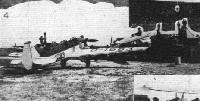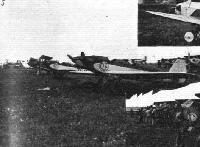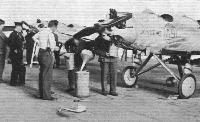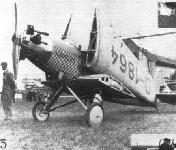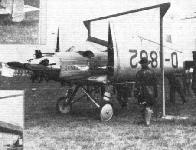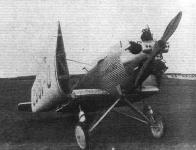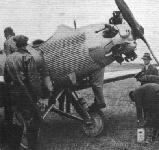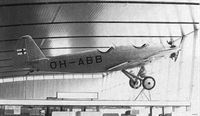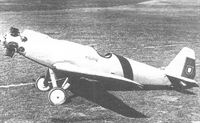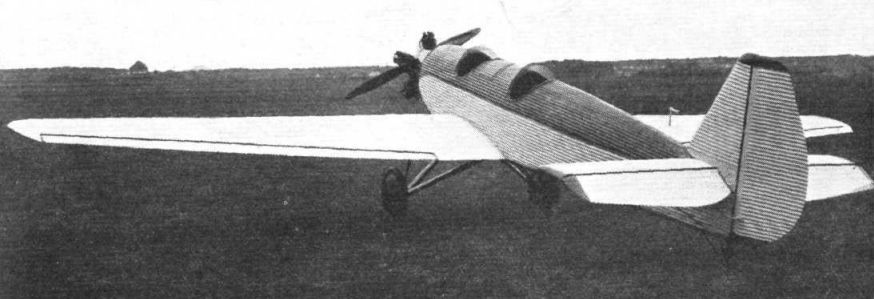
Junkers A 50
В конце 1920-х годов главный конструктор компании "Junkers" Герман Польман начал разработку двухместного цельнометаллического спортивного самолета, получившего обозначение A 50. Идея создания этой машины принадлежала Иоганну Арнтзену из торгового департамента "Junkers", полагавшему, что она будет превосходить деревянные самолеты аналогичного назначения.
A 50, разрабатывавшийся вначале под обозначением EF31, предназначался, прежде всего, для спортивных полетов, обучения и выполнения высшего пилотажа, но мог также использоваться частными пилотами для воздушного туризма и находиться в воздухе до пяти часов. Прототип A 50 совершил первый полет 13 февраля 1929 года, а затем в Дессау построили еще четыре самолета для испытаний, оснащенных различными двигателями и шасси.
Для рекламы нового самолета, начиная с середины 1930 года, компания "Junkers" провела ряд рекордных полетов на высоту и дальность. Оснащенные дополнительными топливными баками A 50 летали из Германии в разные пункты назначения, такие как Тенерифе на Канарах и в Японию. Стартовав 18 августа 1931 года, Марга фон Этцдорф начала одиночный перелет на A 50 из Берлина в Токио, став первой женщиной, совершившей это. В 1932 году другой самолет совершил перелет из Хельсинки в южноафриканский Кейптаун, а затем вернулся в Дессау в Германии.
Компания "Junkers" рассчитывала на большие объемы продаж, но цена самолета оказалась слишком высокой. В результате построили только 69 машин, оснащенных разными двигателями, включая Armstrong Siddeley Genet, Genet II, Genet Major I, Walter и Siemens-Halske Sh 13. Около 50 самолетов A 50 были куплены частными владельцами из Австралии, Бразилии, Германии, Португалии, Финляндии, Швейцарии, Южной Африки и Японии.
ТАКТИКО-ТЕХНИЧЕСКИЕ ХАРАКТЕРИСТИКИ
Junkers A 50be
Тип: двухместный учебный и туристический самолет
Силовая установка: один 5-цилиндровый радиальный двигатель Armstrong Siddeley Genet II мощностью 87 л. с. (65 кВт)
Летные характеристики: максимальная скорость 172 км/ч; крейсерская скорость 145 км/ч; потолок 4600 м; дальность полета 600 км
Масса: пустого 360 кг; снаряженного 600 кг
Размеры: размах крыла 10,00 м; длина 7,12 м; высота 2,40 м; площадь крыла 13,70 м2
Описание:
- Junkers A 50
- Flight, June 1929
OLYMPIA AERO SHOW 1929 - Flight, January 1930
THE JUNKERS "JUNIOR" - Flight, April 1930
AIRCRAFT FOR THE PRIVATE OWNER
Фотографии
-
Flight 1929-07 / Flight
THE NEW JUNKERS LIGHT 'PLANE: The Junkers "Junior" is of all-metal construction. The engine is an Armstrong Siddeley "Genet."
-
Jane's All the World Aircraft 1980 / Encyclopedia of Aviation - Aircraft A-Z - v4
Junkers A 50, a two-seat sporting monoplane built in limited numbers from 1929.
-
Air Enthusiast 1998-09 / J.Grant - Corrugated Masterpieces
Регистрационный номер: VH-UNO A.50 VH-UNO in its original Junkers colours. It survived for only four months in Australia.
-
Air Enthusiast 1998-09 / J.Grant - Corrugated Masterpieces
Регистрационный номер: VH-UCC A.50 VH-UCC, longest-running of the Australian Junkers types.
-
Flight 1934-06 / Flight
VARIETY AT VINCENNES: The illustration shows the Junkers "Junior" flown by Capt. Placedo Abreu, of Portugal.
-
Aeroplane Monthly 1989-01 / M.Oakey - Grapevine
Регистрационный номер: D-2054 Junkers-A 50 Junior D-2054, recently restored by the Deutsches Museum, on display in Munich.
-
Flight 1934-08 / Flight
Регистрационный номер: D-2042 A GERMAN AFRICAN FLIGHT: Edgar Gotthold and his Junkers "Junior" fitted with an Armstrong Siddeley "Genet" engine, in which he recently completed a 15,500 mile flight from Germany to Africa and back. During this flight the "Genet" maintained the reputation of British engines by running faultlessly throughout.
-
Flight 1930-01 / Flight
The luggage locker is placed, in the Junkers "Junior", between the two cockpits.
-
Aeroplane Monthly 1997-06 / H.Amtmann - My Junkers years
The unmarked G 38 prototype, showing the original single-deck fuselage configuration. A Junkers-A 50 Junior all-metal two-seater is in the foreground.
Другие самолёты на фотографии: Junkers G 38 - Германия - 1929
-
Flight 1930-01 / Flight
THE JUNKERS "JUNIOR ": In this three-quarter rear view the machine is shown pegged-out, and with covers over cockpits and engine.
-
Flight 1930-04 / Flight
Регистрационный номер: G-AATH ALL METAL: Mr. Trost (left) and Major Clarke, who brought over their delightful little Junkers Junior to the Reading Meeting.
-
Flight 1929-08 / Flight
Регистрационный номер: D-1683 PETROL TEST AT THE ORLY MEETING: (4) Filling up.
-
Flight 1929-08 / Flight
PETROL TEST AT THE ORLY MEETING: (5) German and English competitors ready to start - the Junkers A.50 (Genets) and two Gipsy-Moths.
Другие самолёты на фотографии: De Havilland Gipsy Moth / Moth X - Великобритания - 1928
-
Flight 1929-08 / Flight
PETROL TEST AT THE ORLY MEETING: (3) Two of the Junkers A.50's fitted with Genet engines, and Capt. Broad's Gipsy-Moth.
Другие самолёты на фотографии: De Havilland Gipsy Moth / Moth X - Великобритания - 1928
-
Flight 1930-08 / Flight
Регистрационный номер: D-1864 [3] Herr Johann Risztics (Junkers-Genet) watches his fuel being measured out after the consumption test.
-
Flight 1930-08 / Flight
Регистрационный номер: D-1864 [3] VARIOUS STYLES OF WING FOLDING: These photographs from the International Touring Competition indicate how aircraft designers of various nationalities provide for reducing space required for garaging machines. 3. another Junkers uses stacking of the wings.
-
Flight 1930-08 / Flight
Регистрационный номер: D-1862 [2] VARIOUS STYLES OF WING FOLDING: These photographs from the International Touring Competition indicate how aircraft designers of various nationalities provide for reducing space required for garaging machines. 2, a Junkers "Junior" with a front spar universal joint.
-
Flight 1930-08 / Flight
Регистрационный номер: D-1862 [2] A Junkers Junior, showing the new method of folding the wings.
-
Flight 1930-08 / Flight
"GENETS" IN LOW-WING MONOPLANES: A Junkers "Junior"
-
Flight 1933-08 / Flight Advertisements
Capt. Bremer and his Siddeley Genet Junkers Junior
-
Flight 1930-07 / Flight
Регистрационный номер: D-1863 JUNKERS "JUNIOR": This machine, photographed at the moment of starting from Berlin, is fitted with a Siemens engine. Others of the same type have the Armstrong-Siddeley "Genet."
-
Flight 1930-07 / Flight
Регистрационный номер: D-1864 [3] SEEN AT HESTON: GERMAN MONOPLANE TAKING PART IN THE COMPETITION: 1, a Junkers "Junior" refuelling.
-
Flight 1933-08 / Flight Advertisements
The Siddeley Genet Junkers Junior
-
Flight 1930-05 / Flight
Flt.-Lt. Stainforth gives a demonstration of Joystick Jerks on a Junkers ''Junior.''
-
Flight 1930-01 / Flight
The Junkers "Junior" in flight: This photograph gives a good idea of the excellent view obtained from the two cockpits. The engine is an Armstrong Siddeley "Genet."
-
Flight 1930-01 / Flight
One of the latest Junkers Junior all-metal machines which has been fitted with an 80/88 H.P. Armstrong Siddeley Genet engine.
-
Aeroplane Monthly 2000-04 / M.Hooks - Gatwick arrivals /Post-war rally/
Регистрационный номер: OH-ABB [4] Major Bremer’s veteran Junkers Junior OH-ABB, its open cockpits wisely covered against the weather, received an award as the most efficient aircraft.
-
Aeroplane Monthly 2000-04 / M.Hooks - Gatwick arrivals /Post-war rally/
Регистрационный номер: OH-ABB [4] Major Bremer’s veteran Junkers Junior OH-ABB. It survives today, suspended in the Helsinki-Vantaa Airport terminal.
-
Flight 1933-11 / Flight
Регистрационный номер: OH-ABB [4] CURIOSITY? "Junior" appears anxious to see what the interior of a Persian hut at Jask looks like.
-
Flight 1932-05 / Flight
Регистрационный номер: OH-ABB [4] FROM FINLAND TO THE CAPE IN A JUNKERS "JUNIOR": As previously recorded in "Flight," Capt. V. E. Bremer, the Finnish airman, recently flew from Finland to Capetown in a Junkers "Junior" (Armstrong-Siddeley "Genet"). Our picture shows Capt. Bremer with his machine about to leave Helsingfors - actually, he flew the "Junior" and did not haul in as shown! During this trip he made two fine non-stop flights, from Naples to Tunis, across the Mediterranean, and from Cairo to Wadi Haifa - a distance of 750 miles in 7 hours.
-
Air Enthusiast 1998-05 / R.Niccoli - Portuguese Numerology
A single Junkers A.50 Junior was operated 1931 to 1934.
-
Aviation Historian 14 / P.Thompson - Young Japan
Described by the international press as “The Lindbergh of Japan”, Seiji Yoshihara stands beside his Armstrong-Siddeley Genet-engined Junkers Junior in which he flew within a week from Berlin to Tokyo via Koenigsberg, Smolensk, Sverdlovsk, Omsk, Krasnoyarsk, Chita, Harbin and Osaka in 1930. He made a failed attempt at a transpacific flight in 1931.
-
Flight 1937-10 / Flight
THE ILL WIND: A corner of Rollason's hangar at Croydon. In the foreground is a Stinson Reliant, with the little Latvian V.E.F. J.12 behind it and the South African Junkers Junior on the right. One of I.A.F.'s Curtiss Condor freighters can be seen in the far distance.
Другие самолёты на фотографии: Curtiss Condor 18 - США - 1929Irbitis, VEF I-11 / I-12 / I-17 - Латвия - 1936Stinson Reliant - США - 1933
-
Мировая Авиация 162
В 1930 году A 50 установил ряд мировых рекордов высоты, дальности полета и скорости на маршруте. Для этого использовали поплавковый вариант A 50 с двигателем Armstrong Siddeley мощностью 79 л. с. (59 кВт).
-
Aeroplane Monthly 1996-08 / T.Gwynn-Jones - A matter of honour
A most unlikely transpacific candidate - an 80 h.p. Genet-engined Junkers-A 50 Junior floatplane trainer similar to that flown by Seiji Yoshihara.
-
Flight 1930-07 / Flight
The Junkers Junior as a seaplane.
-
Flight 1929-07 / Flight
On the Junkers "Junior" the telescopic strut of the undercarriage is attached to the centre section of the wing.
- Фотографии












